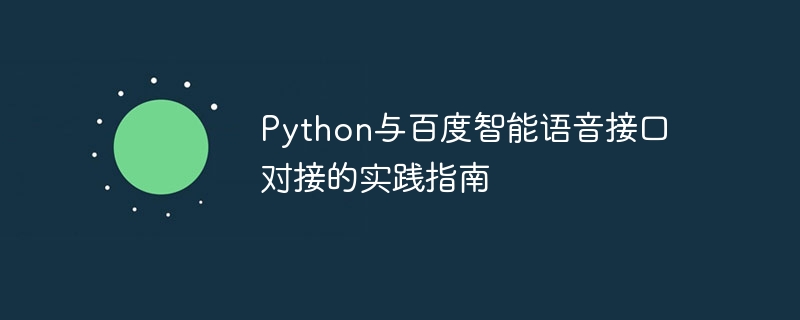

Practical Guide for Interfacing Python with Baidu Intelligent Speech Interface
Introduction:
In the development of modern technology, speech recognition technology has attracted more and more attention. Baidu Intelligent Voice Interface is a powerful voice processing tool that can realize voice recognition, synthesis, wake-up and other functions. This article will introduce how to use Python language to connect with Baidu intelligent voice interface, and give some practical code examples.
1. Preparation work
Before we start, we need to complete some preparation work.
base64
You can use the pip command to install these libraries:
pip install requests pip install pyaudio pip install urllib pip install base64
2. Speech recognition
Next, we will introduce how to use Python language and Baidu intelligent voice interface for speech recognition.
Import the necessary libraries
First, we need to import the necessary libraries in the code:
import requests import json import base64
Get Access Token
Before communicating with Baidu Intelligent Voice Interface, we need to obtain an Access Token for authentication. You can use the following code to obtain Access Token:
def get_access_token(client_id, client_secret): url = 'https://aip.baidubce.com/oauth/2.0/token?grant_type=client_credentials&client_id=' + client_id + '&client_secret=' + client_secret response = requests.post(url) return response.json()['access_token']
Among them, client_id and client_secret were obtained when registering the application on Baidu Smart Cloud.
Upload a voice file and recognize it
The following code example shows how to upload a local voice file and call Baidu intelligent voice interface for recognition:
def speech_recognition(access_token, filepath):
url = 'https://vop.baidu.com/server_api'
with open(filepath, 'rb') as f:
speech = base64.b64encode(f.read())
data = {
'format': 'pcm',
'rate': 16000,
'channel': 1,
'cuid': 'xxxx',
'token': access_token,
'speech': speech,
}
headers = {'Content-Type': 'application/json'}
response = requests.post(url, data=json.dumps(data), headers=headers)
result = response.json()['result']
return resultAmong them, access_token is the Access Token obtained previously, and filepath is the path of the voice file to be recognized.
3. Speech synthesis
In addition to speech recognition, Baidu intelligent voice interface also supports speech synthesis function. The following will introduce in detail how to use Python language and Baidu intelligent voice interface for speech synthesis.
Import the necessary libraries
Similarly, we need to import the necessary libraries in the code:
import requests import json import base64
Text to speech
The following code example shows how to convert a text file into a voice file:
def text_to_speech(access_token, text, filepath):
url = 'https://tsn.baidu.com/text2audio'
data = {
'tex': text,
'tok': access_token,
'cuid': 'xxxx',
'ctp': 1,
'lan': 'zh',
'spd': 5,
'pit': 5,
'vol': 5,
'per': 4,
}
headers = {'Content-Type': 'application/json'}
response = requests.post(url, data=json.dumps(data), headers=headers)
with open(filepath, 'wb') as f:
f.write(response.content)Among them, access_token is the Access Token obtained previously, text is the text content to be converted, and filepath is the path to save the voice file.
Conclusion:
Through the introduction of this article, we learned how to use Python language to connect with Baidu intelligent voice interface, and gave some code examples. By using these examples, we can better utilize the capabilities of Baidu's intelligent voice interface to implement various voice-related applications. I hope this article will be helpful to your docking work in practice.
The above is the detailed content of Practical guide for connecting Python and Baidu intelligent voice interface. For more information, please follow other related articles on the PHP Chinese website!




